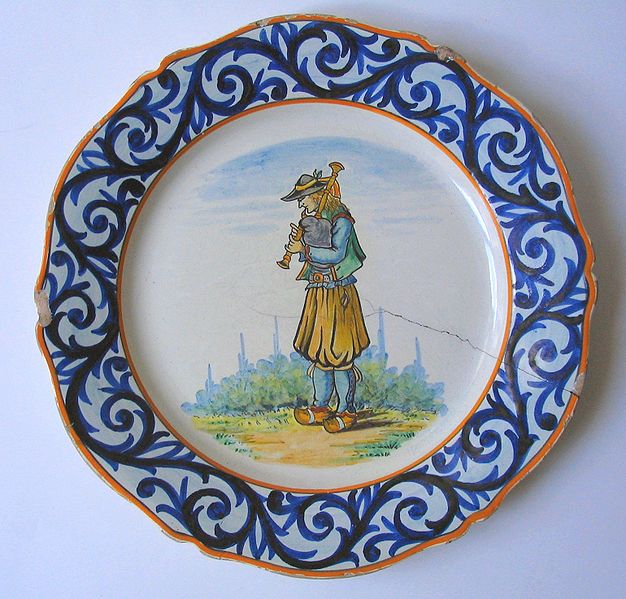April is generally a cool, rainy month, but in between rain showers, there are decorative art events and gardens to visit.
Trompe-l'oeil--Imitations, pastiches, et autres illusions.
At the Musee des Arts Decoratifs, 107 Rue de Rivoli, 1st Arrondissment. This exhibition features items from the museum's storerooms which have never or rarely before been shown. The trompe-l'oeil technique is meant to trick the eye, and dates back to ancient Greece.
This decorative technique took many forms, illustrating materials through painting including wood, lacquer, tiles, velvet, and framed pictures. Many of these works were done primarily for economic reasons, and later included artisans marbling ceramics to imitate jasper, painting to simulate linoleum floorboards, and paste to simulate diamonds.
This decorative technique took many forms, illustrating materials through painting including wood, lacquer, tiles, velvet, and framed pictures. Many of these works were done primarily for economic reasons, and later included artisans marbling ceramics to imitate jasper, painting to simulate linoleum floorboards, and paste to simulate diamonds.
 | |||
| From Musee des Arts Decoratifs |
Plaque mural of birdcage, 1780
If you can't make it to Paris this month, it will be open through January, 2014.
Chateau de Malmaison
Avenue du Chateau de Malmaison, 92500 Rueil-Malmaison.
Located in a northern suburb of Paris, this spectacular Chateau is filled with beautifully decorated rooms and gardens. This country home was purchased in 1797 by Josephine de Beauharnais, wife of Napoleon
Bonaparte and the future king of France. Then a run-down estate, Josephine spent lavishly on the property with the goal of transforming it into "the most beautiful and curious garden in Europe...".
She bought the rarest of plants, and had exotic animals roaming the property, including black swans, kangaroos, emus, zebras, ostriches, antelopes and llamas. The garden is well known for its rose garden with 250 varieties. The famous Belgian artist Redoute drew and recorded her roses; his prints are still popular today.
Josephine received sole ownership of Malmaison after her divorce from Napoleon. She lived there until her death in 1814.
The interior of the house also are a fabulous source of French design inspiration. It is filled with beautiful period antiques, decorative painting techniques, and of course Josephine's luxurious canopy bed.
You can buy a momento of Malmaison here in the United States. Josephine's namesake rose, 'Souvenir de la Malmaison', can be purchased by mail order. I bought mine at www.antiqueroseemporium.com. It is a light pink rose, with a lovely strong tea fragrance.
Bonaparte and the future king of France. Then a run-down estate, Josephine spent lavishly on the property with the goal of transforming it into "the most beautiful and curious garden in Europe...".
She bought the rarest of plants, and had exotic animals roaming the property, including black swans, kangaroos, emus, zebras, ostriches, antelopes and llamas. The garden is well known for its rose garden with 250 varieties. The famous Belgian artist Redoute drew and recorded her roses; his prints are still popular today.
Josephine received sole ownership of Malmaison after her divorce from Napoleon. She lived there until her death in 1814.
The interior of the house also are a fabulous source of French design inspiration. It is filled with beautiful period antiques, decorative painting techniques, and of course Josephine's luxurious canopy bed.
 |
| Salle a Manger (Dining Room), Wikipedia |
 |
| Empress Josephine's Bed, Pinterest |
 |
| The French Farmhouse photo--Souvenir de la Malmaison |
Autour du Chat Noir: Arts and Pleasures in Montmartre, 1880-1910
At the Musee de Montmartre, 12/14 Rue Cortot, 18th Arrondissement. This exhibition evokes the atmosphere of the Black Cat, a Montmartre cabaret founded in 1881 by Rodolphe Salis. This was the first literary, artistic and musical avant-garde in Paris. Guests enjoyed improvisation of songs and music, with shadow theater as the main attraction.Over 200 works of artists d'Henri de Toulouse- Lautrec, Edouard Vuillard, Theophile-Alexandre Steinlen, Adolphe Willete, and the Nabis and the Symbolists are on display. The art works are accompanied by a reconstruction of the theater shadows and music.
The exhibition strives to invoke irony, satire, and humor, and sounds like a very unique artistic experience. It runs through June 2, 2013.
 |
| Chat Noir Exposition Poster |
Other places of note
If you are going to Paris and time permits, the following are favorites of mine.The Jardin du Luxembourg, 6th Arrondissment. This is considered one of the finest gardens in Paris, and spring flowers should be in bloom. Look for the tulips!
Musee du Louvre, 4 Place du Louvre. This most famous museum is always magnificent and inspirational for its vast collections of art and decorative objects. But visitors beware! The museum was shut down April 10th after guards went on strike to protest the pickpockets (apparently growing with frequency and sometimes violent) that are preying upon both visitors and the guards! They have since re-opened, but mind your purses and wallets!
Giverny , Musee Monet,Haute-Normandie 27620. Monet's classic French farmhouse just re-opened for the season --see my 'Monet Inspirations' blog for more details.
You can also order "April in Paris' sweet peas from www.reneesgarden.com. There is still time to plant them this month for bloom this year, unless you are in a mild climate. I planted mine this fall and they are blooming now. This sweet pea has a soft cream center with dark lilac edges. It has the most intense fragrance of sweet pea I have ever grown.
 |
| Renee's Garden Sweet Peas |






